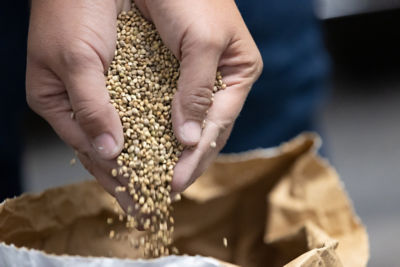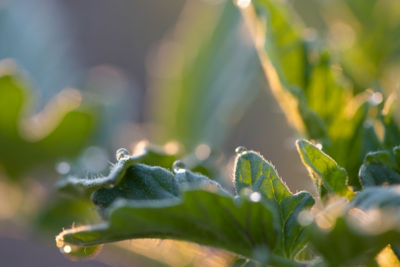Click here to download a PDF version of this spotlight.
» Swede midges can substantially reduce market yield and quality of broccoli, cabbage, and cauliflower crops.
» Midge larvae feed on growing tips and at the bases of flowers.
» Management options include crop rotation, post-harvest sanitation, and the use of insecticides.
The swede midge (Contarinia nasturtii) is a serious insect pest of cruciferous crops, causing damage that reduces market yield and quality.1,2,3 The insect is a relatively new pest in North America, first observed in Ontario, Canada, in 2000. It has since spread to at least seven states and six provinces.4,5 The adult flies are small (1/16th inch, 2 mm long), brown with translucent wings (Figure 1a). The females lay small (0.3 mm), white eggs in clusters of two to fifty. The larvae are initially translucent and 0.3 mm long, eventually become yellow and three to four mm (1/8th inch) long (Figure 1b).1,3,4
 Figure 1. (A) An adult swede midge fly. (B) A swede midge larva. Susan Ellis, USDA APHIS PPQ, Bugwood.org.
Figure 1. (A) An adult swede midge fly. (B) A swede midge larva. Susan Ellis, USDA APHIS PPQ, Bugwood.org.
DAMAGE
Larvae feed at the bases of flowers and on newly emerged growing tips. Feeding results in twisted growth, puckered and crinkled leaves, petioles with swollen bases, and brown scarring (Figure 2). Feeding sites often look wet or moist. Feeding that occurs before the button stage can result in no head formation (blind heads).1,4,5 The severity of damage increases with the number of larvae present, and swede midge populations are usually higher later in the season. However, young plants are more susceptible to damage. Infestations tend to be higher near sheltered areas (hedgerows, buildings, tree-lines), and are often most prevalent downwind from fields planted to brassicas the previous season.1,4
Brassica crops vary in their susceptibility to the swede midge. Broccoli and cauliflower are highly susceptible. Cabbage is moderately susceptible, and the growing point is protected from new infestations once the head forms.1,3 Varieties of broccoli and cabbage also vary in their susceptiblity. Cruciferous weeds can also serve as hosts of the swede midge.
 Figure 2. Brown scarring on petioles resulting from swede midge larval feeding. Julie Kikkert, Cornell University.
Figure 2. Brown scarring on petioles resulting from swede midge larval feeding. Julie Kikkert, Cornell University.
INSECT BIOLOGY
The swede midge overwinters as pupae in the soil in fields, ditches, hedgerows, and weedy areas. Adult flies emerge from the soil in the spring when soils are moist, and temperatures reach 68° to 77°F (20° to 25°C). The adults mate soon after emergence, and females begin to lay eggs within three days.1,2,5 Eggs usually hatch within two to eight days, and the emerged larvae begin to feed on the plant. Larvae grow and develop over seven to twenty-one days, depending on the temperature and the nutritional quality of the host. When mature, the larvae flip off the plant and pupate in the soil.1,2,6 The pupae remain in the soil for seven to forty-nine days, depending on conditions. Pupae developing in the soil at the end of the season will overwinter, emerging the following spring. About two percent of the overwintering pupae will remain in the soil for up to two years. Only pupae in the upper soil layers (top ¾ inch, 2 cm) will emerge. Pupae buried deeper will remain dormant and can emerge when they are brought back to the surface through cultivation or by other means.1,2,4,5,6 The full life cycle usually takes 21 to 44 days. In the Northeast, there are usually three to five overlapping generations, from mid- to late-May through early- to mid-October, depending on the location and conditions.1,2,6
MONITORING
Swede midge infestations are most likely to occur in fields recently planted to cruciferous crops.1 Damage is usually observed after the larvae have left the plants. Effective monitoring involves the use of pheromone traps to detect male adults and regular scouting to look for larvae on growing tips. Traps should be placed on stakes with the trap bottoms 12 inches (30 cm) above the soil and spaced 50 feet apart. Check the traps two to three times per week, and replace the pheromone lures every four weeks.3,4,5,6
Examine flower bases and growing tips for the presence of yellow larvae. The larvae are small, so the use of a 10x or 20x hand lens is usually necessary. Pull back covering leaves to expose the growing tips for examination. Swede midge larvae can look similar to other insect larvae, such as diamondback moth or cabbage worm caterpillars. In addition to the larvae, also look for wetness on the growing tips, a sign of larval feeding.4,5 Scout first along field edges and near sheltered areas such as hedgerows or tree lines.1
MANAGEMENT
The management of swede midge is best accomplished by integrating cultural and chemical control practices because once established, swede midge is difficult to erradicate. Start by selecting fields that are not near and, if possible, upwind from fields that were planted to crucifers the previous season. This includes fields planted to canola and rape cover crops. The adults can fly at least 330 yards (300 m). Recommendations for the minimum distance between current and previous cruciferous crop fields range from 0.6 miles (1 km) to 1 mile (1.6 km). Adult swede midges are weak fliers, so planting in open fields with good crosswinds may offer some protection. Avoid planting in fields surrounded by hedgerows or wooded areas.1,3,4,5,6 A small percentage of pupae remain viable in the soil for at least two years, so a two- to three-year rotation away from cruciferous crops is recommended. Control cruciferous weeds during the rotational period. Sequential planting of cruciferous crops in adjacent fields can allow populations to build quickly; so, sequential plantings should be spaced far apart from each other. For smaller operations where space is limited, it may be best to only plant early or late season crops.1,2,5,6 Chop or plow in plants promptly after harvest to minimize the number of larvae entering the soil to pupate. Side shoots on post-harvest plants provide sites for swede midge larvae development, leading to soil infestation. This is especially problematic for crops harvested during periods of warm weather in the late summer months.1,3,4 Use insect-free transplants. If possible, use transplants grown in areas not affected by the midge. Approved insecticides can be used to treat transplants suspected of being infested.1,4,6 Prevent the introduction of pupae into non-infested fields by cleaning boots, tools, and equipment before moving from infested to non-infested locations. Larval feeding causes more severe damage to younger plants. Planting early can help plants escape infestation at the most susceptible stage. The earlier harvest from early planted crops can also result in less damage. Avoiding a late-season planting will help lower the number of overwintering pupae.1
Exclusion-netting or row covers can be used to prevent adult flies from laying eggs on crop plants and completely control problems with swede midge, but this practice can be expensive. If there are pupae in the soil under the netting, the plants will not be protected. Plastic mulch should be used under the netting to control weeds so that the covers do not need to be removed to allow weeding.3,4 Insecticide treatments can be initiated based on the detection of adult flights using pheromone traps or upon the detection of larva on plants. An action threshold of five to ten males per trap per day allowed for effective treatment for swede midge infestations on cabbage in one study. For broccoli grown in regions with low swede midge populations, an action threshold of one male per trap per day was needed to provide good levels of control. In areas with high populations, an action threshold of one to five males per day provided a level of control equivalent to weekly calendar sprays.6 Because the larvae feed on tissue that is protected by newly forming leaves, systemic insecticides have been the most effective for managing swede midge infestations.3,4 Products containing acetamiprid or spirotetramat can be applied as foliar sprays.4 Mid-season, foliar applications of pyrethroid, carbamate, or organophosphate products may be important in areas with high swede midge populations.5 Acetamiprid, imidacloprid, and thiamethoxam can also be applied as soil drenches.1,5 The insecticides clothianidin or thiamethoxam can provide three to five weeks of protection when applied as seed treatments.5 Weekly applications of kaolin clay, starting immediately after transplanting and continuing through head formation, have provided moderate protection with moderate pest pressure.3,4
SOURCES
1 Swede Midge Information Center for the U.S. http://web.entomology.cornell.edu/shelton/swede-midge/index.html.
2 Hoepting, C. and Brake, V. 2020. New crop rotation recommendations for swede midge. Cornell Cooperative Extension, Vegetable Fact Sheet. https://hdl.handle.net/1813/70145.
3 Hodgdon, Elisabeth A.; Chen, Yolanda H.; Hoepting, Christine A.; Hallett, Rebecca H. 2017. Organic management of swede midge. NYS IPM Program. https://hdl.handle. net/1813/55087.
4 Higgins, G. 2021. Brassicas, swede midge. UMass Extension Vegetable Program. https://ag.umass.edu/vegetable/fact-sheets/brassicas-swede-midge.
5 Phillips, B. 2015. Swede midge biology and management. Michigan State Extension. https://www.canr.msu.edu/news/swede_midge_biology_and_management.
6 Allen, J., Fraser, H., and Hallett, R. 2009. The swede midge – a pest of crucifer crops. OMAFRA, Agdex# 625/252.
Websites verified 9/3/2021
ADDITIONAL INFORMATION
For additional agronomic information, please contact your local seed representative. Performance may vary from location to location and from year to year, as local growing, soil and weather conditions may vary. Growers should evaluate data from multiple locations and years whenever possible and should consider the impacts of these conditions on the grower’s fields. The recommendations in this article are based upon information obtained from the cited sources and should be used as a quick reference for information about broccoli production. The content of this article should not be substituted for the professional opinion of a producer, grower, agronomist, pathologist and similar professional dealing with this specific crop.
BAYER GROUP DOES NOT WARRANT THE ACCURACY OF ANY INFORMATION OR TECHNICAL ADVICE PROVIDED HEREIN AND DISCLAIMS ALL LIABILITY FOR ANY CLAIM INVOLVING SUCH INFORMATION OR ADVICE.
9053_SE_S4 Published 10-05-2021
ALWAYS READ AND FOLLOW PESTICIDE LABEL DIRECTIONS.
Bayer, Bayer Cross Design, and Seminis® are registered trademarks of Bayer Group. All other trademarks are property of their respective owners. © 2021 Bayer Group. All rights reserved.




